Looking to be outdoors in July and August, yet staying cool when temperatures in Paleohora reach the high 30s? Why not explore the Azogires underground system?
You’ll need to make an early start, either by car or taxi to Azogires, or take the 6.15am ‘bus, arriving there 15 minutes later. In the cool of the morning, take the road (left) climbing west out of the village , which leads to the Cave of the 99 Saints. Steadily uphill for 2km, the road passes two hamlets off to the right, and the (incomplete) church of St. John the Russian, then becomes a track, swinging right to a gate, from where a footpath slants uphill towards the rock ridge above, with a prominent white cross . Finally the path drops suddenly through a narrow cleft to the cave entrance.
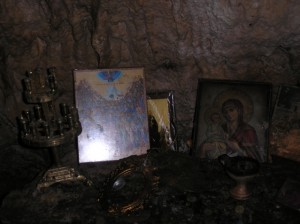
Now the legend of the cave. Once upon a time ….. around the 14th century, a group of 99 Holy Saints came to live in a cave above Azogires. One day their leader, John, left to live a solitary life on the Akrotiri peninsula near Chania, but before leaving, the saints made a pact – that if any one of them should die, so too would all the others. Some time later, John, wearing a sheepskin to keep out the cold, was mistaken for an animal by a hunter, shot with an arrow and killed. The same day villagers found the remaining saints had all died of natural causes.
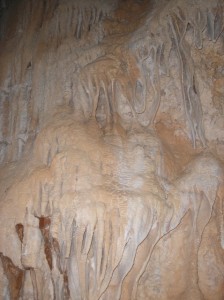
Stalactites hang from the ceilings
Later, bones from the cave were buried at a place below Azogires where a plane tree now grows – extraordinary in that it is evergreen and not the usual deciduous. The tree’s branches grow to form crosses, and according to legend, when 99 crosses have appeared, the tree will die.
And if you believe all that …… but back to the cave entrance! At the foot of iron ladders is a shrine to the 99 Saints, and the more intrepid can explore further into the depths. But never go alone, and ensure you carry a spare torch with you; if you drop or break your only torch, or the batteries run out, it could be serious. Below the shrine is a narrow passage, with a wire cable as a guide, leading to a wooden ladder, and a scramble to where another ladder drops to a huge chamber where the cave system ends, and another small shrine. Dripping stalactites hang from the walls and roof, and maybe some bats.
Exit from the cave is by the same route; climb out into the sunlight and walk back down to Azogires for breakfast at the Alpha cafe/restaurant, where ‘Lucky’ will tell you more about the village, its history and legends. On the wall is a large-scale diagram of the cave system.
If it’s not too hot, walk out of the village to the turning to Asfendiles, 1 km away. The road en route runs above the Azoghirianos river, where there are small waterfalls and pools just deep enough to dip into and cool off. Turn right on the Asfendiles road, and after half a km look for a gate (with a sign) indicating the ‘Koukoutsakis’ caves, belonging to Lucky’s family, and used by shepherds. Only small, and not too easily located, don’t worry if you miss them!
Continue along the road to take a rough track right, sloping down and around the hillside, then keep left to the ‘Carved caves of Ancient Azogires’. The lower cave is easily reached by a metal ladder, but the climb to the main cave is more intimidating! The carved steps and handrail are recent, prior to which rock-climbing techniques were required. ‘Lucky’ tells of how, during German and Turkish occupations, and long before then in Roman times, the village women and children were hauled up in baskets to safety whenever danger threatened. Tall pine trees hid the entrance in former times, and it’s easy to see how people could be kept hidden out of harm’s way.
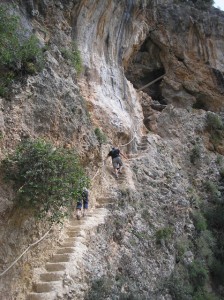
Still not for vertigo sufferers!
There’s a great view from the cave (if you get there) over the valley to Azogires village. Below are the remains of an old Turkish settlement, and you can pick out the ruined Turkish fort on the ridge opposite. Back at ground level, look for the plaque which, if you can read Greek, tells you more about the site.
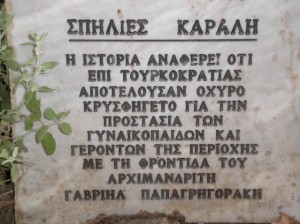
How’s your Greek?
Retrace your steps, and at the fork turn left, downhill. When the track meets the path to Anidri turn right, following blue painted waymarking towards Azogires, passing first the old schoolhouse and then the Monastery, visiting the museum there if it’s open. On reaching the bridge, you could cross to see the ‘Forever Green Platanos tree’ and on up to the village, or, better, keep right to the older stone bridge and then follow waymarking to meet the road.
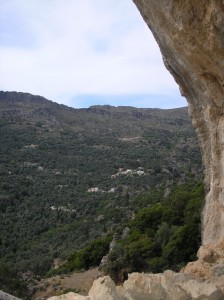
View down to the village from the cave
The ‘Alpha’ is a little way below, and if it’s approaching lunch-time you could sample the ‘specialite de maison’ – ‘Sofia’s World Famous Omelette’.
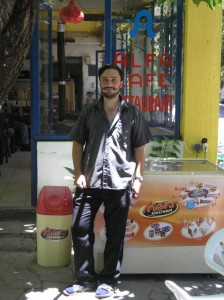
‘Lucky’ at the Alpha Cafe
Lucky may know when (or if!) the bus returns through the village, or will call a taxi for you. Failing that there’s an 8km walk down to Paleohora, with every chance of hitching a lift back into town.


3 comments
spent many a day in the cafe alpha talking to lucky,found it buy luck driving through the mountains.happy days.big respect to bob and lyn,we all lived in kalamos.
one love always
tony cait,shea and tipsy the dog
ps wine from the barrel knocked your socks off.
returning some time soon
lol
Benim atalar?m Bu Köyde ya?am??lar 1897 y?l?nda ya?ad?klar? yeri terk edip Türkiye gelmi?ler soy adlar? orada Kauris olarak bilinirmi? eger bu konu ile ilgili bilginiz varsa eski Türk köyü kal?nt?lar? var diye yazm??s?n?z mail adresim kavuradnan@gmail.com te?ekkür ederim
EDITORS NOTE: I ran this through Google translate and it reads: “My ancestors lived in this village in 1897, Abandoned the place and came to Turkey, the surname names? Is there known as Kauris? Eager if you have any information on this subject, please contact the old Turkish village residences. I have e-mail your address kavuradnan@gmail.com“
From Eftichis (‘Lucky’) Koukoutsakis, Alfa cafe at Azogires : “The Kauri family ruled Azogires and were responsible for some of the infamous massacres ; they lived in upper Azogires in the modern neighbourhood of Kaouriana, and their land extended from Paleochora to Strati. After the Cretan uprisings (1895-97) they were butchered and forced to leave.”
Statistics in the book ‘Paleochora – a Look Back into the Past’ * show that in 1834 Azogires was a totally Moslem village, with 15 Moslem families and 0 Christian. By 1881 30 Christian families outnumbered only 16 Moslem. Rebellion was in the air.
From the same book : “Christians of our area clearly remember the Agha Asis-Kauris and his sons. He was a famous & infamous ‘Jennitsaros’ – a Greek who had been forced to abide by Islamic religion & had received military training. He was the worst enemy of his own homeland. Not only was he known for the brutality with which he proceeded against the Christians in surrounding villages such as Azogires (his village of residence) and Anidri, but he was also considered most infamous and terrifying because of his dishonourable and immorable behaviour. An Albanian finally killed Agha Asis-Kauris on the orders of Mustafa Pasha.”
* On sale at ‘To Delfini’ bookshop, Paleochora